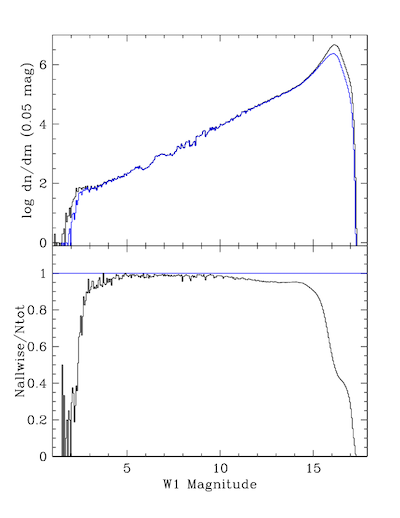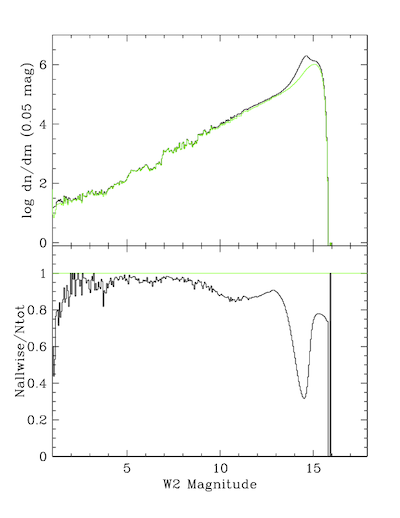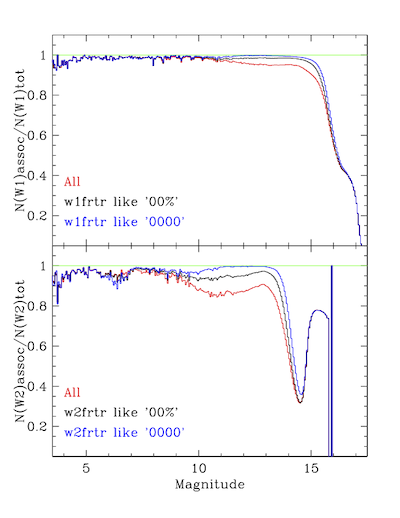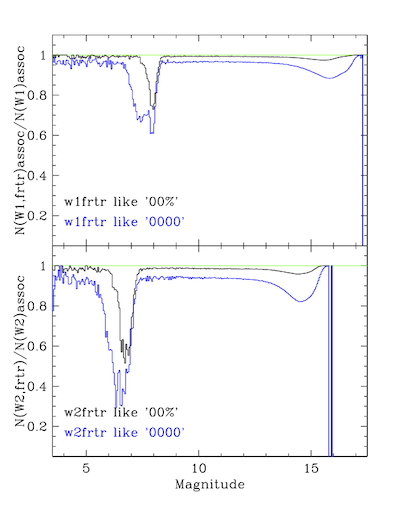


90% completeness is achieved for NEOWISE Single-exposure detections in unconfused regions at W1=15.8 mag and W2=14.2-14.4 mag.
The completeness of the NEOWISE Single-exposure detections is estimated using the multiple, independent observations for each point on the sky made during regular survey operations. This is done for a 2.4 deg2 region near α,δ=163.2°,-19.7° that was observed approximately 300 times during the NEOWISE Reactivation mission. The NEOWISE Single-exposure Source Database contains approximately 7.5 million entries within its boundaries. Truth tables of reliable W1 and W2 detections that extend fainter than the Single-exposure detection limit are generated by running the WSDS Multiframe Pipeline that coadds the Single-exposures covering the region, and then performs deep source detection and extraction (the Multiframe Pipeline was not run during normal NEOWISE data processing). The Single-exposure completeness within a magnitude interval is then defined as the ratio of the number of times truth-table sources are detected on the Single-exposures to the total number of times they were observed. The brightness from the deep source extractions is used to determine in which magnitude interval sources are binned.
The resulting W1 and W2 Single-exposure detection completeness as a function of magnitude curves were derived separately for each year of NEOWISE observations, and are shown in Figure 1. The Single-exposure detection completeness of the original WISE mission is also shown for comparison. In year eleven, 90% completeness is achieved for the NEOWISE Single-exposures at approximately W1=15.8 mag and W2=14.3 mag. There was <0.1 mag degradation of the W1 completeness levels since the first year of the Reactivation survey, and approximately 0.3 mag since the primary WISE mission. In the eighth year of the Reactivation mission the 90% completeness levels in W2 had degraded by approximately 0.2 mag since the first year and approximately 0.5 mag since the primary WISE mission. However, the W2 completeness actually improved in years nine and ten most likely due to the lower peak temperatures.
In addition to detections of solar system, galactic and extragalactic objects, the NEOWISE Single-exposure Source Database contains a large number of spurious detections of noise excursions, image artifacts and transient frame and pixel events.
The NEOWISE Single-exposure Source Database contains all detections made on all Single-exposure Images, regardless of their reliability or quality. The relatively low detection SNR threshold used during NEOWISE data processing (combined W1 and W2 SNR>3) ensures a high degree of completeness for real sources, but also results in an increasing fraction of spurious detections of noise excursions towards fainter fluxes. In addition, the NEOWISE Single-exposure Source Database contains spurious detections of image artifacts from bright stars, transient events such as charged particle strikes, satellite trails, and hot and noisy pixels that can occur at any brightness. Many of the spurious artifact detections are flagged (e.g., cc_flags and w?frtr), but a significant number are not.
The majority of reliable source detections in the Source Database are background galactic and extragalactic objects, and will have counterparts in the deeper AllWISE Source Catalog. Therefore, positional association with AllWISE Catalog sources is a good proxy for NEOWISE detection reliability. Approximately 68% of the entries in the NEOWISE Single-exposure Source Database (136,321,732,073 detections) have associated AllWISE Source Catalog sources within 3 arcseconds. Most of the remaining 32% of the detections are likely spurious detections of noise or image artifacts. A small fraction of these may be reliable detections of moving solar system objects, stars with proper motions approximately >0.75 arcsec/year, or sources that brightened considerably since the primary WISE survey.
To illustrate how the fractional reliability of NEOWISE Source Database detections varies with brightness, the differential counts of W1 and W2 detections in the database within 5° of the north Galactic pole are shown plotted as a function of magnitude in the upper panels of Figures 2 and 3. The total counts are shown by the black curves in the figures, and the counts of Database entries that have AllWISE Catalog associations are shown by the blue/green curves. In the lower panels of Figures 2 and 3 are shown the ratios of the number of database entries with AllWISE associations in each magnitude bin to the total number of detections in that bin.
The downward turn in the fractional reliability curves in Figures 2 and 3 at W1>15.0 and W2>13.0 mag indicates the brightness at which faint noise detections begin to comprise a significant fraction of the Source Database entries. The secondary peak in the W2 reliability fraction near 15.5 mag is an artifact of very low SNR W2 noise detections that are pulled along by brighter W1 detections.
 |
 |
| Figure 2 - W1 | Figure 3 - W2 |
|---|---|
| (top panels) Differential counts as a function of magnitude for entries in the NEOWISE Single-exposure Source Database within 5° of the north Galactic pole. The black curves are the total counts. The blue (W1) and green (W2) curves are the detections that have AllWISE Source Catalog associations. | |
| (bottom panels) The ratio of the number of Source Database entries with AllWISE associations to the total number in 0.05 mag-wide bins. | |
The reliability of detections brighter than W1=15.0 and W2=13.0 mag never reaches 100% because of the presence of spurious detections of bright star image artifacts and transient events such as charged particle strikes, satellite trails and hot pixels. These effects can induce detections at nearly any brightness. Most of the unreliable detections in the brightness ranges 11<W1<15 and 10<W2<14 mag are caused specifically by artificial transients such as charged-particle strikes. This is illustrated in Figure 4 which shows how NEOWISE reliability in these brightness ranges improves using different levels of filtering of detections that are flagged to have transient pixels in or around their position with the w?frtr flags. However, such filtering comes with a small cost in completeness, as shown in Figure 5 which shows the fraction of putative reliable detections (those with AllWISE Source Catalog counterparts), using the two levels of transient filtering. Transient filtering should not be used for bright detections near W1 and W2 saturation because the pixel masking that is tracked by the w?frtr flags breaks down near the cores of some saturated sources.
General tips on how to use the different parameters in the NEOWISE Single-exposure Source Database to select reliable detections of solar system and background objects with good quality measurements are presented in II.3.b.
 |
 |
| Figure 4 - The fractional reliability of W1 (top) and W2 (bottom) NEOWISE Source Database detections in 0.05 mag-wide bins with different degrees of filtering on transient detection flagging. Red curves: no filtering, corresponding to the curves in the bottom panels of Figures 2 and 3. Black curves: moderate filtering, corresponding to detections that have w?frtr like '00%'. Blue curves: severe filtering, corresponding to detections that have w?frtr like '0000'. | Figure 5 - The fraction of NEOWISE Single-exposure detections with AllWISE Source Catalog counterparts that are removed by the two different levels of transient flagging shown in Figure 4. Transient pixel detection has difficulties near the cores of saturated sources, so transient detection filtering should not be used for detections with W1<9 and W2<8 mag. |
Last Updated: 10 October 2024


